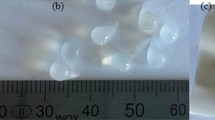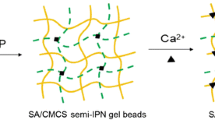Abstract
The aim of this study was to fabricate composite gel beads based on natural polysaccharides. Hyaluronic acid (HA) and Chitosan (CS) were successfully admixed with Ca2+/alginate (SA) gel system to produce SA/HA/CS gel beads by dual crosslinking: the ionic gelation and the polyelectrolyte complexation. The preparation procedure was that the weight ratio of SA (2%, m/v) to HA (2%, m/v) was kept at 2:1, then the mixture was dripped into the Ca2+ solution for ion-crosslinking, and finally polyelectrolyte crosslinked with 2% low molecular weight CS (LMW-CS) for 1.5 hours. The optimal formulation was achieved by adjusting the concentration and the weight ratio of SA, HA and LMW-CS. Due to the incorporation of HA and LMWCS, the swelling ratio of the beads at pH 7.4 was increased up to 120, and the time for the maximum swelling degree was prolonged to 7.5 h. The swelling behavior was obviously improved compared to the pure SA/Ca2+ system. The preliminary results clearly suggest that the SA/HA/CS gel beads may be a potential candidate for biomedical delivery vehicles.
Similar content being viewed by others
References
Bae YH, Kim SW. Hydrogel Delivery Systems based on Polymer Blends, Block Co-polymers or Interpenetrating Networks [J]. Adv. Drug Deliver. Rev., 1993, 11: 109–135
Peppas NA, Sahlin JJ. Hydrogels as Mucoadhesive and Bioadhesive Materials: A Review [J]. Biomaterials, 1996, 17: 1553–1561
Yamanlar S, Sant S, Boudou T, et al. Surface Functionalization of Hyaluronic Acid Hydrogels by Polyelectrolyte Multilayer Films [J]. Biomaterials, 2011, 32: 5590–5599
Hoffman AS. Hydrogels for Biomedical Applications [J]. Adv. Drug Deliver. Rev., 2002, 43:3–12
Qiu Y, Park K. Environment-Sensitive Hydrogels for Drug Delivery [J]. Adv. Drug Deliver. Rev., 2012, 64:49–60
Sun X, Shi J, Xu X, et al. Chitosan Coated Alginate/Poly(Nisopropylacrylamide) Beads for Dual Responsive Drug Delivery [J]. Int. J. Biol. Macromol., 2013, 59: 273–281
Chung C, Beecham M, Mauck RL, et al. The Influence of Degradation Characteristics of Hyaluronic Acid Hydrogels on in vitro Neocartilage Formation by Mesenchymal Stem Cells [J]. Biomaterials, 2009, 30: 4287–4296
Hasan B, Gumusderelioglu M, Orbey MT. Release Characteristics of Salmon Calcitonin from Dextran Hydrogels for Colon-Specific Delivery [J]. Eur. J. Pharm. Biopharm., 2007, 65: 39–46
George M, Abraham TE. pH Sensitive Alginate-Guar Gum Hydrogel for the Controlled Delivery of Protein Drugs [J]. Int. J. Pharm., 2007, 335: 123–129
Orive G, Castro MD, Kong HJ, et al. Bioactive Cell-Hydrogel Microcapsules for Cell-Based Drug Delivery [J]. J. Control Release, 2009, 135: 203–210
Chan ES, Yim ZH, Phan SH, et al. Encapsulation of Herbal Aqueous Extract through Absorption with Ca-Alginate Hydrogel Beads [J]. Food Bioprod. Process, 2010, 88:195–201
Ribeiro CC, Barrias CC, Barbosa MA. Calcium Phosphate-Alginate Microspheres as Enzyme Delivery Matrices [J]. Biomaterials, 2004, 25: 4363–4373
Hennink WE, Nostrum CF. Novel Crosslinking Methods to Design Hydrogels [J]. Adv. Drug Deliver. Rev., 2002, 54, 13–36
Esposito E, Cortesi R, Nastruzzi C. Gelatin Microspheres: Influence of Preparation Parameters and Thermal Treatment on Chemico-Physical and Biopharmaceutical Properties [J]. Biomaterials, 1996, 17: 2009–2016
Tomme SRV, Geest BGD, Braeckmans K, et al. Mobility of Model Proteins in Hydrogels Composed of Oppositely Charged Dextran Microspheres Studied by Protein Release and Fluorescence Recovery after Photobleaching [J]. J. Control Release, 2005, 110: 67–78
Martins AF, Facchi SP, Monteiro JP, et al. Preparation and Cytotoxicity of N, N, N-trimethyl Chitosan/Alginate Beads Containing Gold Nanoparticles [J]. Int. J. Biol. Macromol., 2015, 72: 466–471
Kim WT, Chung H, Shin I, et al. Characterization of Calcium Alginate and Chitosan-Treated Calcium Alginate Gel Beads Entrapping Allyl Isothiocyanate [J]. Carbohydr. Polym., 2008, 71: 566–573
Lin YH, Liang HF, Chung CK, et al. Physically Crosslinked Alginate/ N, O-Carboxymethyl Chitosan Hydrogels with Calcium for Oral Delivery of Protein Drugs [J]. Biomaterials, 2005, 26: 2105–2113
Sikorski P, Mo F, Skjåk-Bræk G, et al. Evidence for Egg-Box-Compatible Interactions in Calcium-Alginate Gels from Fiber X-ray Diffraction [J]. Biomacromolecules, 2007, 8: 2098–2103
Kaygusuz H, Erim FB. Alginate/BSA/Montmorillonite Composites with Enhanced Protein Entrapment and Controlled Release Efficiency [J]. React. Funct. Polym., 2013, 73: 1420–1425
George M, Abraham TE. Polyionic Hydrocolloids for the Intestinal Delivery of Protein Drugs: Alginate and Chitosan-a Review [J]. J. Control Release, 2006, 114: 1–14
Nochos A, Douroumis D, Bouropoulos N. In Vitro Release of Bovine Serum Albumin from Alginate/HPMC Hydrogel Beads [J]. Carbohydr. Polym., 2008, 74: 451–457
Hua SB, Ma HZ, Li X, et al. pH-Sensitive Sodium Alginate/Poly(Vinyl Alcohol) Hydrogel Beads Prepared by Combined Ca2+ Crosslinking and Freeze-Thawing Cycles for Controlled Release of Diclofenac Sodium [J]. Int. J Biol. Macromol., 2010, 46: 517–523
Sanem AS, Peter K, Martin LY. Effect of Complexation Conditions on Xanthan-Chitosan Polyelectrolyte Complex Gels [J]. Food Hydrocolloid., 2009, 23: 202–209
Luo Y, Wang Q. Recent Development of Chitosan-Based Polyelectrolyte Complexes with Natural Polysaccharides for Drug Delivery [J]. Int. J Biol. Macromol., 2014, 64: 353–367
Bhattarai N, Gunn J, Zhang M. Chitosan-based Hydrogels for Controlled, Localized Drug Delivery [J]. Adv. Drug Deliver. Rev., 2010, 62: 83–99
Matricardi P, Meo CD, Coviello T, et al. Interpenetrating Polymer Networks Polysaccharide Hydrogels for Drug Delivery and Tissue Engineering [J]. Adv. Drug Deliver. Rev., 2013, 65: 1172–1187
Vashist A, Gupta YK, Ahmad S. Interpenetrating Biopolymer Network Based Hydrogels for an Effective Drug Delivery System [J]. Carbohydr. polym., 2012, 87: 1433–1439
Pascalau V, Popescu V, Popescu GL, et al. The Alginate/k-Carrageenan Ratio’s Influence on the Properties of the Cross-linked Composite Films [J]. J Alloy Compd., 2012, 536S: S418–S423
Kutty JK, Cho EH, Lee JS, et al. The Effect of Hyaluronic Acid Incorporation on Fibroblast Spreading and Proliferation within PEGDiacrylate Based Semi-Interpenetrating Networks [J]. Biomaterials, 2007, 28: 4928–4938
Yang J, Chen J, Pan D, et al. pH-Sensitive Interpenetrating Network Hydrogels Based on Chitosan Derivatives and Alginate for Oral Drug Delivery [J]. Carbohydr. Polym., 2013, 92: 719–725
Abd EMA, Hashem MS, El-Awady MK, et al. pH-Sensitive Sodium Alginate Hydrogels for Riboflavin Controlled Release [J]. Carbohydr. Polym., 2012, 89: 667–675
Nayaka AK, Pal D. Development of pH-Sensitive Tamarind Seed Polysaccharide-Alginate Composite Beads for Controlled Diclofenac Sodium Delivery Using Response Surface Methodology [J]. Int. J. Biol. Macromol., 2011, 49:784–793
Tavakol M, Vasheghani-Farahani E, Dolatabadi-Farahani T, et al. Sulfasalazine Release from Alginate-N, O-Carboxymethyl Chitosan Gel Beads Coated by Chitosan [J]. Carbohydr. Polym., 2009, 77, 326–330
Widjaja LK, Bora M, Chan PNPH, et al. Hyaluronic Acid-Based Nanocomposite Hydrogels for Ocular Drug Delivery Applications [J]. J. Biomed. Mater. Res. Part A, 2014, 102: 3056–3065
Author information
Authors and Affiliations
Corresponding author
Additional information
Funded by the National Natural Science Foundation of China (No. 81401510)
Rights and permissions
About this article
Cite this article
Hu, Y., Zheng, M., Dong, X. et al. Preparation and characterization of alginate-hyaluronic acid-chitosan based composite gel beads. J. Wuhan Univ. Technol.-Mat. Sci. Edit. 30, 1297–1303 (2015). https://doi.org/10.1007/s11595-015-1311-6
Received:
Accepted:
Published:
Issue Date:
DOI: https://doi.org/10.1007/s11595-015-1311-6




